Symbol Technologies VC5090 Vehicle Computer User Manual
Symbol Technologies Inc Vehicle Computer
users manual
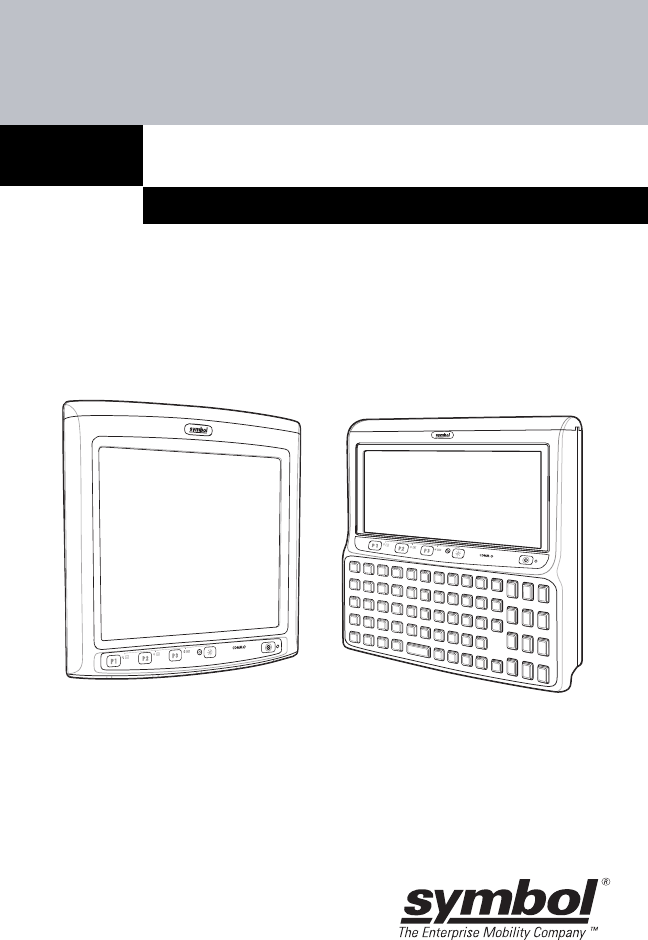
Quick Reference Guide
VC5090 Vehicle Computer
PRELIMINARY

2 VC5090 Vehicle Computer
© 2006 SYMBOL TECHNOLOGIES, INC. All rights reserved.
Symbol reserves the right to make changes to any product to improve
reliability, function, or design.
Symbol does not assume any product liability arising out of, or in
connection with, the application or use of any product, circuit, or
application described herein.
No license is granted, either expressly or by implication, estoppel, or
otherwise under any patent right or patent, covering or relating to any
combination, system, apparatus, machine, material, method, or process
in which Symbol products might be used. An implied license exists only
for equipment, circuits, and subsystems contained in Symbol products.
Symbol and the Symbol logo are registered trademarks of Symbol
Technologies, Inc. Other product names mentioned in this manual may
be trademarks or registered trademarks of their respective companies
and are hereby acknowledged.
Symbol Technologies, Inc.
One Symbol Plaza
Holtsville, N.Y. 11742-1300
http://www.symbol.com
Warranty
Subject to the terms of Symbol’s hardware warranty statement, the
VC5090 Vehicle Computer products are warranted against defects in
workmanship and materials for a period of one year from the date of
shipment. For the complete Symbol hardware product warranty
statement, go to: http://www.symbol.com/warranty.
Patents
This product is covered by one or more patents. For patent information
go to: http://www.symbol.com/patents.

Quick Reference Guide 3
Introduction
The VC5090 Vehicle Computer is a vehicle or fixed-mount computer.
The VC5090 has two configurations: a full-screen computer with optional
keyboard and a half screen configuration with a built in keyboard. You
can enter data using the touch screen, the keyboard, an optional bar
code scanner, or a combination of the three. The data is transmitted
wireless to a host computer. The vehicle computer features:
• Ergonomic design with color LCD touch screen
• Internal wide-range power supply (9 - 72 VDC) to accommodate
propane, gasoline, and electric-powered forklifts
• Internal antennas with external antenna port
• Interfaces with scanners, printers, audio devices and other
peripherals
• Continuous operation at -30°C (-22°F) (cold storage terminals)
• Pre-loaded with terminal emulation software.
About This Guide
This guide contains the following:
•Features on page 4
•Unpacking on page 5
•Optional Accessories on page 6
•Charging the Internal Backup Battery on page 20
•Calibrating the Touch Screen on page 21
•Resetting the Vehicle Computer on page 21
•Programmable Keys on page 22
•Connecting Accessories on page 22
•Maintenance on page 23
•Troubleshooting on page 24.
For more information including installation instructions, refer to the
VC5090 Product Reference Guide, p/n 72E-76347-xx available at
http://www.symbol.com/manuals.
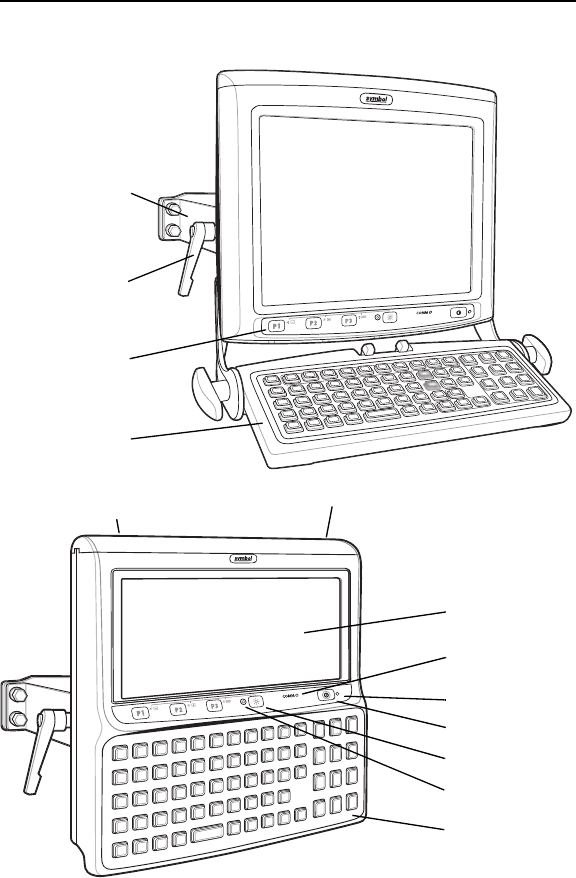
4 VC5090 Vehicle Computer
Features
Optional Keyboard
Angle Adjustment
Knob
Power LED
Antenna Port for Optional
External Antenna
Display
Built-In Keyboard
Control Button
Main Power Switch
User
Programmable
Buttons
Power Button
Control LED
WLAN COMM
LED
Mounting Bracket
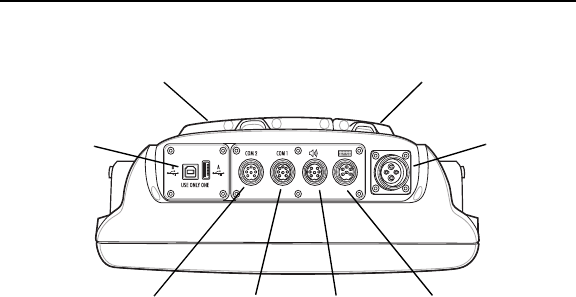
Quick Reference Guide 5
Unpacking
You should find the following items in the box:
• VC5090 vehicle computer
• mounting bracket
• hardware bag
• desiccant kit
• three fuses and three fuse holders
• power cable
• non-abrasive screen protector
• four 3/8 x 6 x 2” cap screws, eight flat washers, eight lock washers
and four hex nuts
• this guide.
Optional Accessories
• Heated keyboard with bracket assembly
• Scanners and cables
• Headsets
• Vehicle Motion Detector Kit
Desiccant Door
COM1 Port
Connector
COM2 Port
Connector
USB
Keyboard
Connector
UPS/Storage Card Door
Audio
Connector
USB Ports
C
lient or Host) Power
Connector
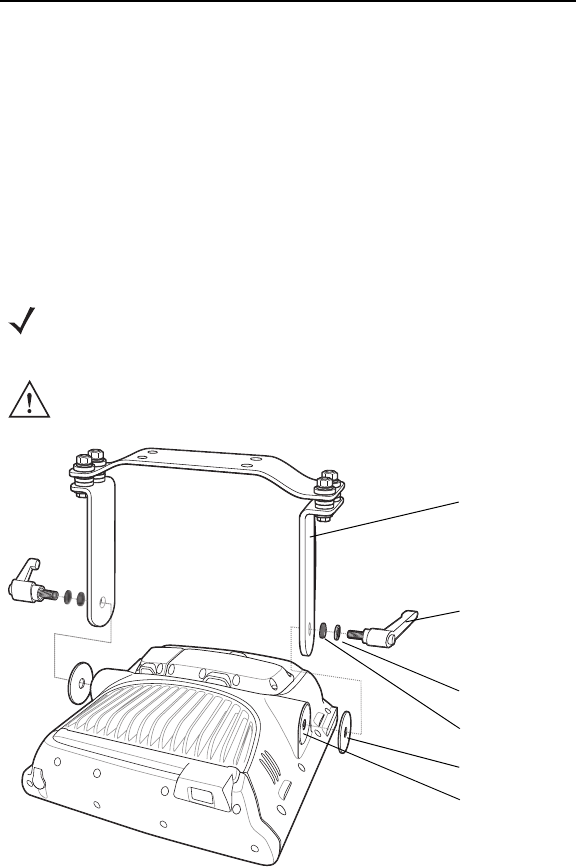
6 VC5090 Vehicle Computer
• Printer cables
• RS-232 and USB ActiveSync cables
• AC power supply
• Uninterruptable power supply (UPS)
• Replacement desiccant bag kit.
Refer to the VC5090 Product Reference Guide for information on
installation the vehicle computer in a vehicle or mounted on a wall.
Mounting Bracket Installation
NOTE The vehicle computer and bracket must be firmly secured
to a surface that can support the vehicle computer’s weight.
CAUTION Symbol requires that the Symbol Mounting Bracket be
used when mounting the vehicle computer.
Mounting
Bracket
Flat Washer
Lock
Washer
Friction Pad
Ergonomic
Handle
Friction Pad
Mounting Area

Quick Reference Guide 7
Installing the Desiccant Bags
1. Remove the tape securing the desiccant door to the back housing.
2. Open the desiccant package and remove the six desiccant bags.
3. Place three desiccant bags in the desiccant well.
4. Place the other three desiccant bags in the back of the desiccant door.
5. Carefully place the desiccant door onto the back housing. Ensure that
the desiccant packets do not interfere with placement of the door.
6. Secure the door to the back housing using the four screws. Torque to
8 ± 0.5 kgf.cm.
Installing the VC5090 in a Forklift
Follow the instructions below to properly install the VC5090 in a forklift.
• Determine the best location for mounting the vehicle computer taking
into consideration the driver’s field of view and ease of accessing the
vehicle computer.
• Install the appropriate mounting hardware.
• Connect the vehicle computer to the vehicle’s wiring system.
Positioning the Vehicle Computer
• Determine the best position for the vehicle computer and all the
associated components. If a similar vehicle computer was previously
installed, check to see if the position it used is suitable for the
VC5090.
• Test the installation for at least 30 minutes before installing on another
vehicle. Record all details:
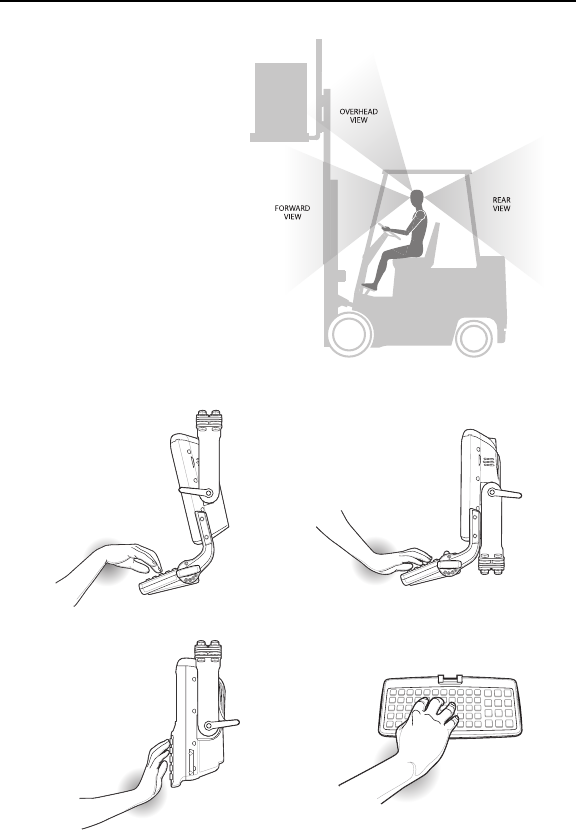
8 VC5090 Vehicle Computer
-Check that the positions
of the vehicle computer
does not obstruct
vehicle controls.
-Check that the vehicle
computer does not
obstruct the driver's
view.
-Check the position of
the vehicle computer for
user comfort over long
periods.
-Check positioning to
avoid extreme wrist
angles that may cause injury.
Avoid Extreme Wrist Angles
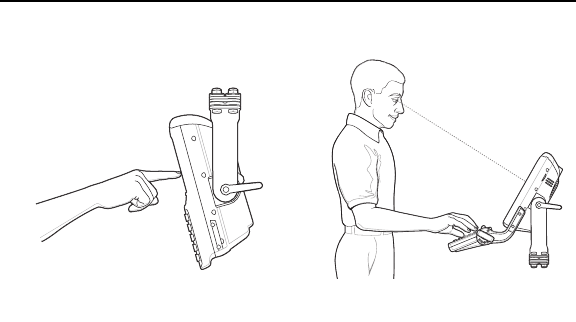
Quick Reference Guide 9
Mounting the Vehicle Computer
Important Fixing Information
Any modification to supplied mounting bracket could cause early failure
of the unit/mountings.
• A minimum of four fixing positions must be used.
• All nuts and bolts must be checked periodically and tightened if
required.
• When installing the vehicle computer, care must be taken to ensure
that the mounting bracket footprint is fully supported. Additional plates
may be required to achieve this.
Mounting Bracket Template
Refer to the VC5090 Product Reference Guide for mounting template.
Mounting onto an Over-Head Cross-Beam Example
The diagram below illustrates a typical installation where the vehicle
computer is mounted onto a cross-beam.
Optimum Wrist Position
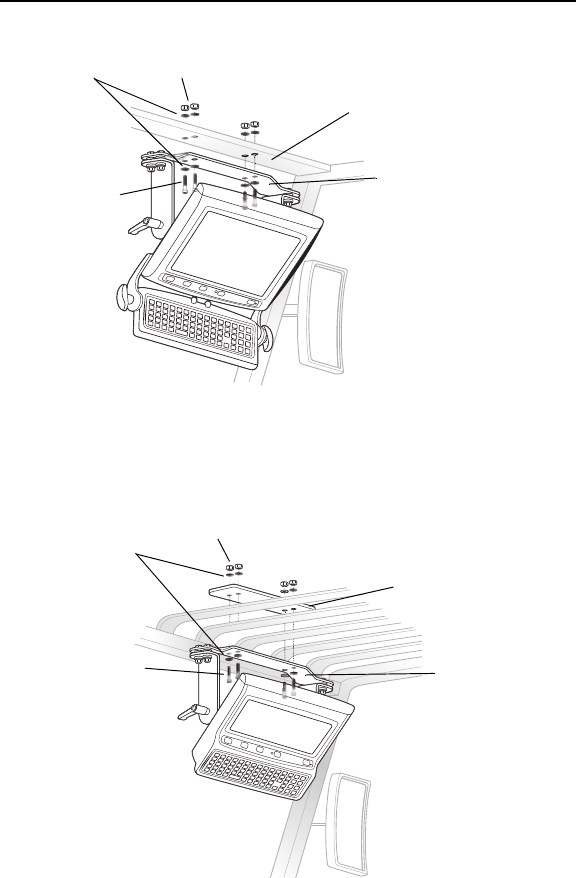
10 VC5090 Vehicle Computer
Mounting onto an Over-Head Cage
The diagram below illustrates a typical installation where the vehicle
computer is mounted on a cage.
Nuts
Washers
Bolts
Vehicle
Cross-Beam
Mounting
Bracket
Nuts
Washers
Bolts
Customer Supplied
Mounting Bracket
Mounting
Bracket
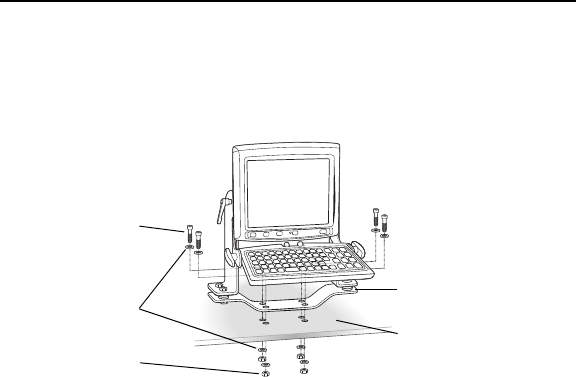
Quick Reference Guide 11
Mounting on a Dashboard or Horizontal Surface
The diagram below illustrates a typical installation where the vehicle
computer is mounted on a dashboard or hortizontal flat surface.
Routing Electrical Cables
• Establish a neat route for the cable, staying clear of moving parts or
hot surfaces wherever possible.
• Fix the cable to existing cable runs inside the vehicle using cable ties,
but make sure they are away from any moving or hot surfaces.
• When the cabling must go through a panel, use a suitable gland.
• When fixing the conduit or cable on the outside of a vehicle, use
P-Clips. Either drill and tap the hole or use a nut and bolt to secure the
clip.
• Make sure the cable does not have tight bends. The minimum
recommended radius is 2.5".
• Solder all fuse holders. DO NOT crimp.
• After soldering the fuse holder, file the solder flat where it comes in
contact with the fuse.
• On electric vehicles, take the power from as close to the battery as
possible, but not directly from the battery terminals, and not before
any main fuse.
Nuts
Washers
Bolts
Mounting Bracket
Mounting
Surface

12 VC5090 Vehicle Computer
• On gasoline, diesel or propane vehicles, take the power from as close
to the battery terminals as possible, and avoid using existing wiring.
• All fuses must be as close as possible to the power source.
• If you are unsure of the correct power source, contact the vehicle
manufacturer for more information.
12-24V Gasoline, Diesel, or Propane Forklifts
• All power wiring must use the supplied power cable.
• Fuse in positive rail = 20A
• Fuse in negative rail = 20A
• Fuse in switched positive = 1A
• Keep the path between the battery and the vehicle computer as short
as possible, and away from any part of the ignition high tension
system.
WARNING!A lead acid battery can leak hydrogen gas. A spark
anywhere near the battery can cause it to explode.
Always make your final connection to power as far
away from the battery as possible, i.e., connect the
power cable to the battery first, then the vehicle
computer.
CAUTION Use extreme care when routing and securing this
cable from the vehicle computer to the vehicle
power source. Hazards associated with improper
wiring can be severe. To avoid unintentional contact
between the wire and any sharp edges, use proper
bushings and clamping where the cable passes
through openings. If the wire is subjected to sharp
surfaces and excess engine vibration, the wiring
harness insulation can wear away, causing a short
between the bare wire and chassis. This can start a
fire.
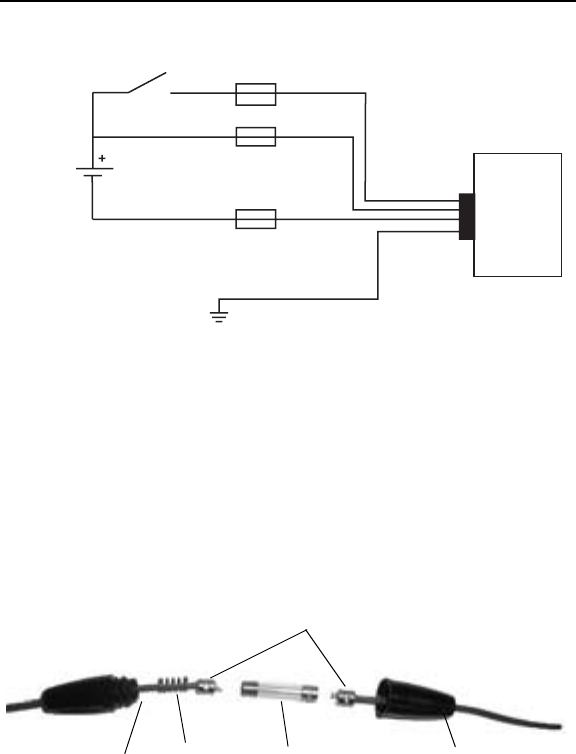
Quick Reference Guide 13
1. Connect the green wire to the vehicle's chassis. If you cannot find a
close connection point, solder an extra length of cable to the green
wire to extend the connection to the chassis. Use a heat shrink to
cover the solder joint.
2. Crimp a ring terminal onto the green wire and screw the ring terminal
into the vehicle metal work. Or, if a bolt connection exists, attach the
ring terminal to this connection (check the connection with a
multi-meter to the vehicle chassis if you’re not sure).
3. Place a fuse holder in-line of the red, black and yellow wires
approximately four inches from the cable end, as shown below.
4. Solder the fuse terminal ends to the wire to ensure a proper electrical
connection. Use a heat shrink to cover the solder joint.
VC5090
FUSE - 20A
FUSE - 1A
Ignition Switch
FUSE - 20A
Chassis ground
Vehicle
Battery
Power Cable
25-71919-01
Yellow
Red
Green
Black
Fuse Holder Fuse HolderSpring Fuse
Fuse Terminal Ends

14 VC5090 Vehicle Computer
5. Connect the red wire to the vehicle's positive power source. Connect
the black wire to the vehicle's negative power source. To terminate the
cable:
• If the vehicle has a power output connector, use a mating connector.
You may be able to connect to a fuse panel with a commercially
available connector.
• If the vehicle has no power output connector, use a ring terminal (for a
battery post) or blade terminal (for a fuse panel).
6. Connect the yellow wire to the vehicle's ignition switch. If you do not
plan on using the ignition switch connection, connect the yellow wire
to the vehicle’s positive power source.
See your vehicle Owner's Manual for more information.
7. Ensure the wiring connections created are sufficiently insulated from
each other.
8. Re-connect the vehicle battery.
9. Insert the power cable connector into the vehicle computer's Power
port. Align the keyway on the power connector with the notch on the
vehicle computer’s power port.
Electric Forklifts Up to 60V
WARNING!A lead acid battery can leak hydrogen gas. A spark
anywhere near the battery can cause it to explode.
Always make your final connection to power as far
away from the battery as possible, i.e., connect the
power cable to the battery first, then the vehicle
computer.
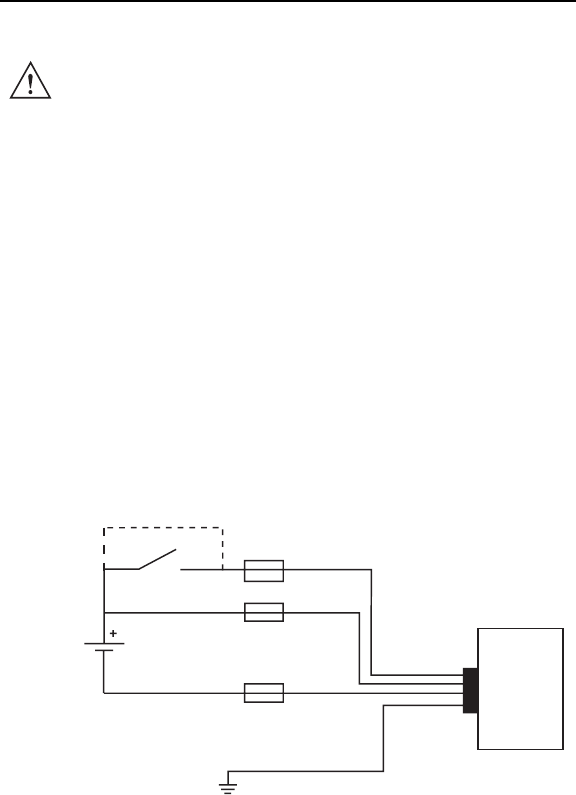
Quick Reference Guide 15
• All power wiring must use the supplied power cable.
• Fuse in positive rail = 20A
• Fuse in negative rail = 20A
• Fuse in switched positive = 1A
• Use a filtered supply if available on the forklift. Consult the forklift
manufacturer for details.
CAUTION Use extreme care when routing and securing this
cable from the vehicle computer to the vehicle
power source. Hazards associated with improper
wiring can be severe. To avoid unintentional contact
between the wire and any sharp edges, use proper
bushings and clamping where the cable passes
through openings. If the wire is subjected to sharp
surfaces and excess engine vibration, the wiring
harness insulation can wear away, causing a short
between the bare wire and chassis. This can start a
fire.
VC5090
FUSE - 20A
FUSE - 1A
Switch
FUSE - 20A
Chassis ground
Vehicle
Battery
Power Cable
25-71919-01
Yellow
Red
Green
Black
or
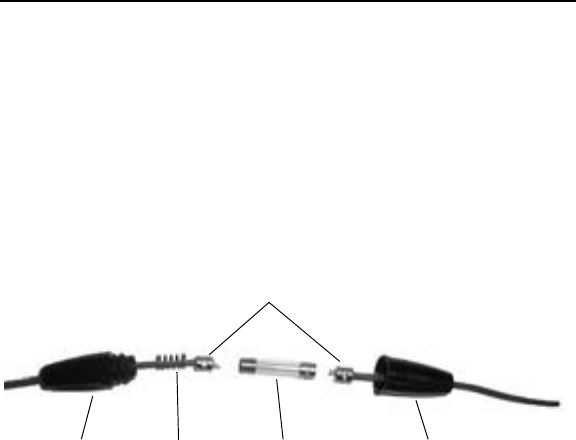
16 VC5090 Vehicle Computer
1. Connect the green wire to the vehicle’s chassis. If you cannot find a
close connection point, solder an extra length of cable to the green
wire to extend the connection to the chassis. Use a heat shrink to
cover the solder joint.
2. Crimp a ring terminal onto the green wire and screw the ring terminal
into the vehicle metal work. Or, if a bolt connection exists, attach the
ring terminal to this connection (check the connection with a
multi-meter to the vehicle chassis if you’re not sure).
3. Place a fuse holder in-line of the red, black and yellow wires
approximately four inches from the cable end, as shown below.
1. Solder the fuse terminal ends to the wire to ensure a proper electrical
connection. Use a heat shrink to cover the solder joint.
2. Connect the red wire to the vehicle's positive power source. Connect
the black wire to the vehicle's negative power source. To terminate the
cable:
• If the vehicle has a power output connector, use a mating connector.
You may be able to connect to a fuse panel with a commercially
available connector.
• If the vehicle has no power output connector, use a ring terminal (for a
battery post) or blade terminal (for a fuse panel).
3. Connect the yellow wire to the vehicle's ignition switch. If you do not
plan on using the ignition switch connection, connect the yellow wire
to the vehicle’s positive power source.
See your vehicle Owner's Manual for more information.
Fuse Holder Fuse HolderSpring Fuse
Fuse Terminal Ends
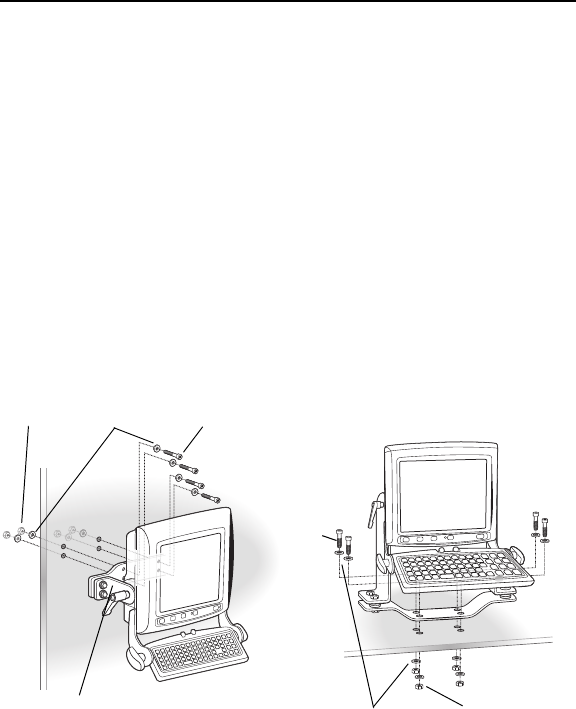
Quick Reference Guide 17
4. Ensure the wiring connections created are sufficiently insulated from
each other.
5. Re-connect the vehicle battery.
6. Insert the power cable connector into the vehicle computer's Power
port. Align the keyway on the power connector with the notch on the
vehicle computer’s power port.
Installing the VC5090 on a Wall or Desktop
To use the vehicle computer in a wall or desktop mounted application:
1. If mounting the vehicle computer on a wall, use the optional wall
mounting bracket.
2. Install the mounting bracket to the wall or desktop using four bolts,
eight washers and four nuts.
1. Insert the DC power cable into the DC connector on the universal
power supply.
2. Plug the other end of the cable into the vehicle computer’s power port.
3. Insert the AC line cord into the AC connector on the universal power
supply.
Bolts
Washers
Nuts
Bolts
Washers Nuts
Optional Wall
Mounting Bracket
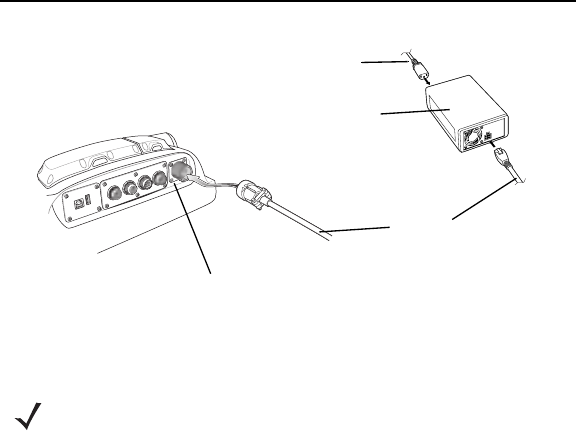
18 VC5090 Vehicle Computer
1. Plug the other end of the AC power cable into a wall outlet.
Installing the Optional Keyboard
The keyboard kit contains the following items:
• keyboard
• keyboard brackets (2)
• four M4 screws and washers
• two locking knobs.
1. Attach the keyboard brackets to both sides of the VC5090, using the
M4 screws and washers, as shown below:
NOTE The optional keyboard is only available for the full-screen
configuration.
DC Power Cable
(25-71920-01)
Universal Power Supply
(50-14001-004)
AC Line Cord
Power Port
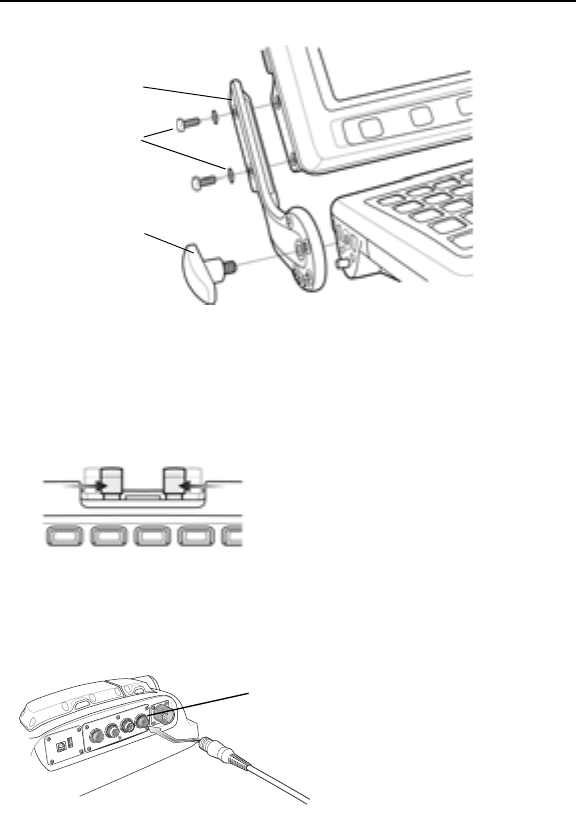
Quick Reference Guide 19
• Torque the screws to 230 kgf/cm.
1. Squeeze the levers on the keyboard and align the keyboard with the
brackets.
2. Release the levers to insert the mechanism bars through an
adjustment hole on each of the brackets.
3. Insert the keyboard locking knobs through the brackets and screw into
the keyboard.
4. Plug the keyboard cable into the USB/Keyboard connector.
Locking Knob
Left Hand Bracket
M4 Screws &
Washers
USB/Keyboard
Connector
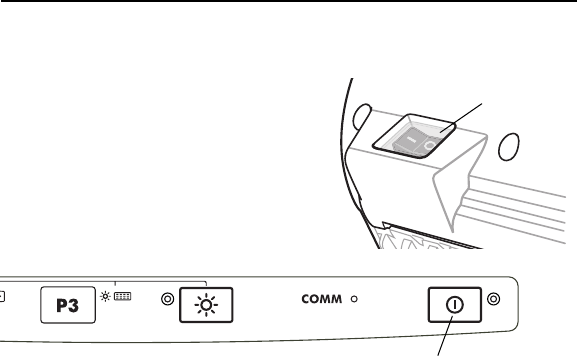
20 VC5090 Vehicle Computer
Powering the VC5090 On/Off
The Main Power switch provides power
to the VC5090. You should only use this
switch when removing power completely
from the device.
Use the Power button on the front panel
to place the VC5090 into Suspend mode
or wake the VC5090 from Suspend
mode.
Charging the Internal Backup Battery
When you receive your VC5090, leave the VC5090 powered on for 24
hours to fully charge the internal backup battery. Note that the VC5090
can charge the backup battery while in Suspend mode, but not if power
is removed.
The internal battery maintains the RAM memory for 72 hours when fully
charged. The data in the Flash memory or Flash file system is not
affected by the state of charge.
Calibrating the Touch Screen
The VC5090 prompts you to calibrate the touch screen when you first
power on the VC5090.
1. Carefully press and hold the stylus on the center of each target.
Repeat as the target moves around the screen.
2. Tap the screen to accept the settings when the calibration is complete.
Main Power Switch
Power Button
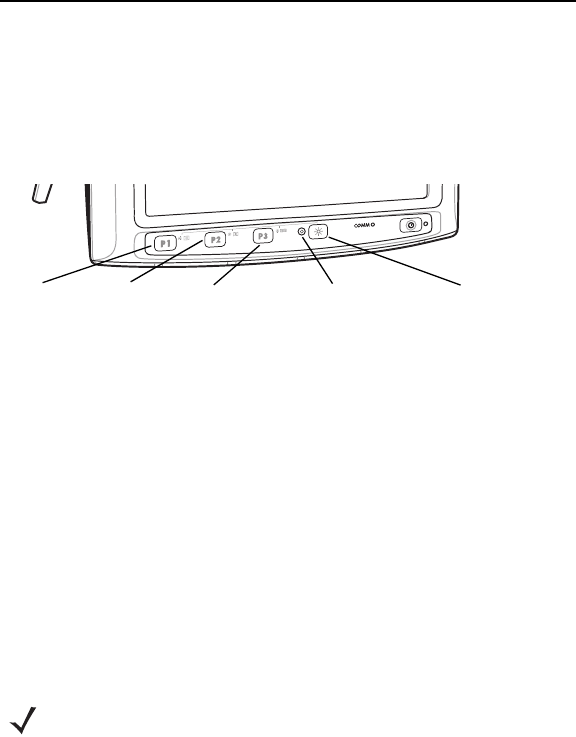
Quick Reference Guide 21
Controlling Screen Brightness
There are four levels of screen brightness. To adjust the brightness of the
screen, press the Control button on the front panel. The amber Control
LED lights indicating that the VC5090 is in the control mode. Press the
P1 button to decrease the brightness or the P2 button to increase the
brightness. Press the Control button to exit this mode.
Controlling Keyboard Backlight
To toggle the keyboard backlight on and off, press the Control button on
the front panel. The amber Control LED lights indicating that the VC5090
is in the control mode. Press the P3 button to toggle the keyboard backlit.
Press the Control button to exit this mode.
Resetting the Vehicle Computer
If your vehicle computer stops responding to inputs, perform a warm boot
or cold boot.
Performing a Warm Boot
A warm boot restarts the vehicle computer and saves all stored records
and entries. In the Windows CE environment, the working registry is
replaced by the latest saved copy of the registry.
To perform a warm boot, press the Power button and the P2 button
simultaneously and release.
NOTE Files that remain open during a warm boot may not be
retained.
Control LEDP2 ButtonP1 Button P3 Button Control Button

22 VC5090 Vehicle Computer
Performing a Cold Boot
A cold boot restarts the vehicle computer, but erases all stored records
and entries in RAM. Data saved in flash memory or a memory card is not
lost. In addition it returns formats, preferences and other settings to the
factory default settings. There are two ways to perform a cold boot:
• Simultaneously press and hold the Power, P1 and P3 buttons.
• Turn off the Main Power switch on the top of the vehicle computer,
then turn it on again, and then press the Power button.
Programmable Keys
The programmable keys on the front panel (P1, P2, P3) can be set to
perform certain functions, such as switching between applications or
emulator sessions.
To set a programmable key:
1. From the Start menu, select Settings > Control Panel.
2. Select the Programmable Keys icon.
3. In the Key: drop-down list, select the key you would like to program.
4. In the Action drop-down list, select the function to assign to the key to
perform.
5. Tap OK.
Connecting Accessories
Connect an optional scanner, ActiveSync serial or USB cable, audio or
USB device using the appropriate connector on the bottom of the
VC5090. Cables are available from Symbol.
You may also use the USB port for ActiveSync connection, if the serial
ports are used for another purpose. This cable is also available from
Symbol. Refer to the VC5090 Product Reference Guide for
information of additional accessories.

Quick Reference Guide 23
Maintenance
The vehicle computer is factory-sealed (except for the desiccant door
and UPS/SD Card door) and contains no user-serviceable parts. Only
qualified Symbol Service Centers should service the vehicle computer.
Use the protective caps that came with the vehicle computer to protect
unused connectors.
• Clean the casing, keyboard, and display window by wiping with a soft
cloth. Use a damp cloth if necessary.
• Never use solvents or abrasive cleaners. You may damage the
display or keyboard.
Desiccant Bag Replacement
Optional desiccant bags can be used in environments where
condensation is a concern. Six desiccant bags are placed in the smaller
well on the back housing. Remove the four securing the door. See
Installing the Desiccant Bags on page 7 for installing the desiccant bags.
Discard the original screws and replace the door using the screws that
come with the new desiccant kit.

24 VC5090 Vehicle Computer
Troubleshooting
Problem Cause Solution
VC5090 does
not power on or
shuts off
suddenly.
Power switch on top of
vehicle computer is in the
Off position.
Turn the power switch to the On
position.
Power cable not
connected or unplugged.
Connect power cable to power cable
port on underside of vehicle
computer. Press the Power button to
boot up the VC5090.
If VC5090 is powered by a
vehicle battery, the vehicle
battery is depleted.
Replace or charge the vehicle
battery.
Cannot see
characters on
display.
VC5090 not powered on. Check that the main power switch on
the top of the VC5090 is in the On
position.
Press the Power button.
Screen is too bright/dark. Adjust the brightness; see
Controlling Screen Brightness on
page 21.
VC5090 is in Suspend
mode (green Power LED
is off)
Press the Power button to turn on the
VC5090.
Application
does not
respond.
VC5090 is not
communicating with the
AP (Communication LED
is off).
Bring the VC5090 closer to the AP. If
problem continues, contact your
System Administrator.
Optional
scanner does
not operate.
Scanner is not properly
connected to the VC5090.
Connect the scanner to the COM1
port and power up the vehicle
computer. If the problem continues,
refer to the scanner Quick Reference
Guide or see your System
Administrator.
ScanWedge application is
not enabled or set to the
correct COM Port.
Ensure that the Scan Wedge
application is enabled and set to the
correct port. See VC5090 Product
Reference Guide for more
information.

Quick Reference Guide 25
Regulatory Information
All Symbol devices are designed to be compliant with rules and
regulations in locations they are sold and will be labeled as required.
Regulatory Information is available in French, Italian, German, Spanish
(Spain), Portuguese, Japanese, Korean, Russian, Simplified Chinese
and Traditional Chinese. Please see following website:
http://www.symbol.com/services/manuals/ and look for your specific
product.
Any changes or modifications to Symbol Technologies equipment, not
expressly approved by Symbol Technologies, could void the user's
authority to operate the equipment.
Antennas: Use only the supplied or an approved replacement antenna.
Unauthorized antennas, modifications, or attachments could cause
damage and may violate regulations.
Products Equipped with Bluetooth
®
Wireless Technology
This product contains Bluetooth Complimentary Subsystems:
• BT ID:B01825
• BT ID:B02413
Country Approvals
Regulatory markings are applied to the device signifying the radio(s) are
approved for use in the following countries: United States, Canada,
Australia, Japan and Europe 1, 2.
CAUTION Only use Symbol approved and UL Listed accessories,
battery packs and battery chargers.
Do NOT attempt to charge damp/wet mobile computers or
batteries. All components must be dry before connecting
to an external power source.

26 VC5090 Vehicle Computer
Please refer to the Symbol Declaration of Conformity (DoC) for details of
other country markings. This is available at
http://www2.symbol.com/doc/.
Note 1: For 2.4GHz Products: Europe includes, Austria, Belgium, Czech
Republic, Cyprus, Denmark, Estonia, Finland, France, Germany,
Greece, Hungary, Iceland, Ireland, Italy, Latvia, Liechtenstein, Lithuania,
Luxembourg, Malta, Netherlands, Norway, Poland, Portugal, Slovak
Republic, Slovenia, Spain, Sweden, Switzerland and the United
Kingdom.
Note 2: The use of 5GHz RLAN's has varying restrictions of use; please
refer to the Symbol Declaration of Conformity (DoC) for details.
Health and Safety Recommendations
Ergonomic Recommendations
• Reduce or eliminate repetitive motion
• Maintain a natural position
• Reduce or eliminate excessive force
• Keep objects that are used frequently within easy reach
• Perform tasks at correct heights
• Reduce or eliminate vibration
• Reduce or eliminate direct pressure
• Provide adjustable workstations
• Provide adequate clearance
• Provide a suitable working environment
• Improve work procedures.
Operation of the device without regulatory approval is illegal.
CAUTION In order to avoid or minimize the potential risk of
ergonomic injury follow the recommendations below.
Consult with your local Health & Safety Manager to ensure
that you are adhering to your company's safety programs
to prevent employee injury.

Quick Reference Guide 27
Vehicle Installation
RF signals may affect improperly installed or inadequately shielded
electronic systems in motor vehicles (including safety systems). Check
with the manufacturer or its representative regarding your vehicle. You
should also consult the manufacturer of any equipment that has been
added to your vehicle.
An air bag inflates with great force. DO NOT place objects, including
either installed or portable wireless equipment, in the area over the air
bag or in the air bag deployment area. If in-vehicle wireless equipment is
improperly installed and the air bag inflates, serious injury could result.
Position your device within easy reach. Be able to access your device
without removing your eyes from the road.
Warnings for Use of Wireless Devices
Please observe all warning notices with regard to the usage of wireless
devices.
Potentially Hazardous Atmospheres
You are reminded of the need to observe restrictions on the use of radio
devices in fuel depots, chemical plants etc. and areas where the air
contains chemicals or particles (such as grain, dust, or metal powders)
and any other area where you would normally be advised to turn off your
vehicle engine.
Hearing Aids
The wireless device may interfere with some hearing aids. In the event of
interference you may want to consult your hearing aid supplier to discuss
solutions.
NOTE Connection to an alert device that will cause a vehicle horn to
sound or lights to flash, on receipt of a call on public roads, is
not permitted.

28 VC5090 Vehicle Computer
Other Medical Devices
Please consult your physician or the manufacturer of the medical device,
to determine if the operation of your wireless product may interfere with
the medical device.
FCC / EU RF Exposure Guidelines
Safety Information
The device complies with Internationally recognized standards covering
Specific Absorption Rate (SAR) related to human exposure to
electromagnetic fields from radio devices.
Reducing RF Exposure - Use Properly
It is advisable to use the device only in the normal operating position.
Remote and Standalone Antenna Configurations.
To comply with FCC RF exposure requirements, antennas that are
mounted externally at remote locations or operating near users at
stand-alone desktop of similar configurations must operate with a
minimum separation distance of 20 cm from all persons.
To satisfy FCC RF exposure requirements, a mobile transmitting device
must operate with a minimum separation distance of 20 cm or more from
a person's body.
Power Supply
Use only a Symbol approved power supply 50-14001-004 output rated
12 Vdc and minimum 9 A. The power supply is certified to EN60950-1
with SELV outputs. Use of alternative power supply will invalidate any
approval given to this device and may be dangerous.
Batteries
Please follow the local regulations when disposing of re-chargeable
batteries.
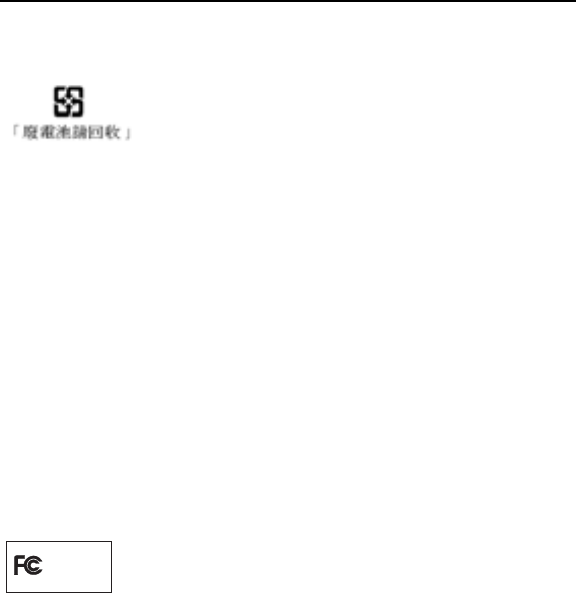
Quick Reference Guide 29
Taiwan - Recycling
EPA (Environmental Protection Administration)
requires dry battery producing or importing firms in
accordance with Article 15 of the Waste Disposal Act
are required to indicate the recycling marks on the
batteries used in sales, giveaway or promotion. Contact a qualified
Taiwanese recycler for proper battery disposal.
Wireless Devices - Countries
Country Roaming
This device incorporates the International Roaming feature
(IEEE802.11d) which will ensure the product operates on the correct
channels for the particular country of use.
Ad-Hoc Operation
Ad-Hoc operation is limited to Channels 36-48 (5150-5250 MHz). Use of
this band is restricted to Indoor Use Only, any other use will make the
operation of this device illegal.
Radio Frequency Interference Requirements
Note: This equipment has been tested and found to
comply with the limits for a Class B digital device,
pursuant to Part 15 of the FCC rules. These limits are
designed to provide reasonable protection against harmful interference
in a residential installation. This equipment generates, uses, and can
radiate radio frequency energy and, if not installed and used in
accordance with the instructions, may cause harmful interference to
radio communications. However there is no guarantee that interference
will not occur in a particular installation. If this equipment does cause
harmful interference to radio or television reception, which can be
determined by turning the equipment off and on, the user is encouraged
to try to correct the interference by one or more of the following
measures:
• Reorient or relocate the receiving antenna
Tested to comply
with FCC Standards
FOR HOME OR OFFICE USE

30 VC5090 Vehicle Computer
• Increase the separation between the equipment and receiver
• Connect the equipment into an outlet on a circuit different from that to
which the receiver is connected
• Consult the dealer or an experienced radio/TV technician for help.
Radio Transmitters (Part 15)
This device complies with Part 15 of the FCC Rules. Operation is subject
to the following two conditions: (1) this device may not cause harmful
interference, and (2) this device must accept any interference received,
including interference that may cause undesired operation.
Radio Frequency Interference Requirements - Canada
This Class B digital apparatus complies with Canadian ICES-003. Cet
appareil numérique de la classe B est conforme à la norme NMB-003 du
Canada.
Radio Transmitters
This device complies with RSS 210 of Industry & Science Canada.
Operation is subject to the following two conditions: (1) this device may
not cause harmful interference and (2) this device must accept any
interference received, including interference that may cause undesired
operation.
Label Marking: The Term “IC:” before the radio certification only signifies
that Industry Canada technical specifications were met.
Marking and European Economic Area (EEA)
The use of 2.4 GHz RLAN's, have the following restrictions:
• Maximum radiated transmit power of 100 mW EIRP in the frequency
range 2.400 -2.4835 GHz
• France, equipment is restricted to 2.4 - 2.454 GHz
• Italy requires a user license for outside usage.

Quick Reference Guide 31
The use of 5GHz RLAN's has varying restrictions for use within the EEA;
please refer to the Symbol Declaration of Conformity (DoC) for details at
http://www2.symbol.com/doc/
Bluetooth® Wireless Technology for use through the EEA has the
following restrictions:
• Maximum radiated transmit power of 100mW EIRP in the frequency
range 2.400 -2.4835 GHz
• France, outside usage is restricted to 10mW EIRP
• Italy requires a user license for outside usage.
Statement of Compliance
Symbol Technologies, Inc., hereby, declares that this device is in
compliance with the essential requirements and other relevant provisions
of Directives 1999/5/EC. Declaration of Conformities may be obtained
from http://www2.symbol.com/doc/
Other Countries
2.4GHz Radio Devices:
Mexico - Restrict Frequency Range to: 2.450 - 2.4835 GHz.
Sri Lanka - Restrict Frequency Range to: 2.400 - 2.430 GHz.
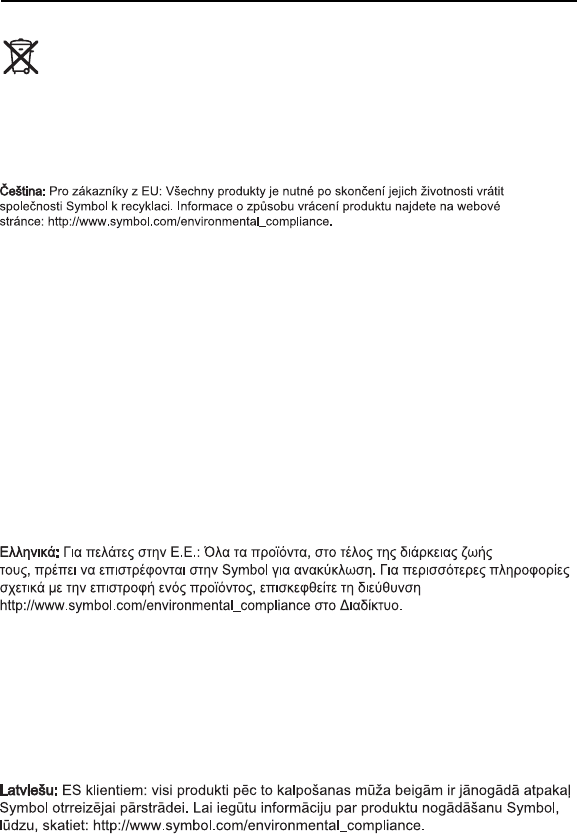
32 VC5090 Vehicle Computer
Waste Electrical and Electronic Equipment
(WEEE)
English: For EU Customers: All products at the end of their life must be returned to
Symbol for recycling. For information on how to return product, please go to:
http://www.symbol.com/environmental_compliance.
Dansk: Til kunder i EU: Alle produkter skal returneres til Symbol til recirkulering, når de
er udtjent. Læs oplysningerne om returnering af produkter på:
http://www.symbol.com/environmental_compliance.
Deutsch: Für Kunden innerhalb der EU: Alle Produkte müssen am Ende ihrer
Lebensdauer zum Recycling an Symbol zurückgesandt werden. Informationen zur
Rücksendung von Produkten finden Sie unter
http://www.symbol.com/environmental_compliance.
Eesti: EL klientidele: kõik tooted tuleb nende eluea lõppedes tagastada
taaskasutamise eesmärgil Symbol'ile. Lisainformatsiooni saamiseks toote tagastamise
kohta külastage palun aadressi: http://www.symbol.com/environmental_compliance.
Español: Para clientes en la Unión Europea: todos los productos deberán entregarse a
Symbol al final de su ciclo de vida para que sean reciclados. Si desea más información
sobre cómo devolver un producto, visite:
http://www.symbol.com/environmental_compliance.
Français: Clients de l'Union Européenne : Tous les produits en fin de cycle de vie
doivent être retournés à Symbol pour recyclage. Pour de plus amples informations sur
le retour de produits, consultez : http://www.symbol.com/environmental_compliance.
Italiano: per i clienti dell'UE: tutti i prodotti che sono giunti al termine del rispettivo ciclo
di vita devono essere restituiti a Symbol al fine di consentirne il riciclaggio. Per
informazioni sulle modalità di restituzione, visitare il seguente sito Web:
http://www.symbol.com/environmental_compliance.
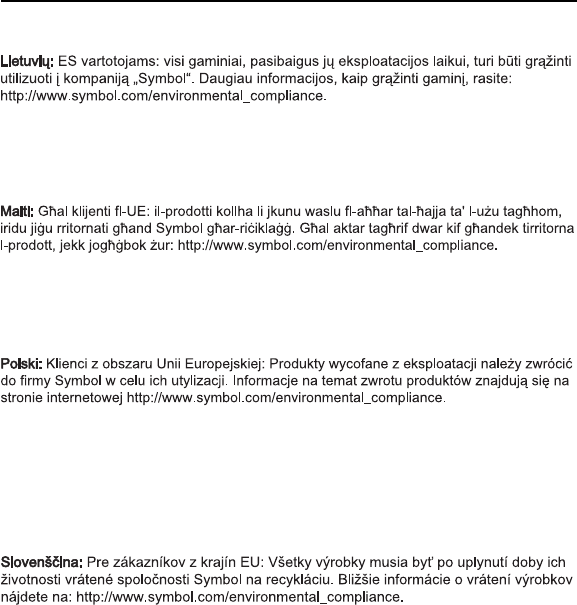
Quick Reference Guide 33
Magyar: Az EU-ban vásárlóknak: Minden tönkrement terméket a Symbol vállalathoz
kell eljuttatni újrahasznosítás céljából. A termék visszajuttatásának módjával
kapcsolatos tudnivalókért látogasson el a
http://www.symbol.com/environmental_compliance weboldalra.
Nederlands: Voor klanten in de EU: alle producten dienen aan het einde van hun
levensduur naar Symbol te worden teruggezonden voor recycling. Raadpleeg
http://www.symbol.com/environmental_compliance voor meer informatie over het
terugzenden van producten.
Português: Para clientes da UE: todos os produtos no fim de vida devem ser
devolvidos à Symbol para reciclagem. Para obter informações sobre como devolver o
produto, visite: http://www.symbol.com/environmental_compliance.
Slovenski: Za kupce v EU: vsi izdelki se morajo po poteku življenjske dobe vrniti
podjetju Symbol za reciklažo. Za informacije o vraèilu izdelka obišèite:
http://www.symbol.com/environmental_compliance.
Suomi: Asiakkaat Euroopan unionin alueella: Kaikki tuotteet on palautettava
kierrätettäväksi Symbol-yhtiöön, kun tuotetta ei enää käytetä. Lisätietoja tuotteen
palauttamisesta on osoitteessa http://www.symbol.com/environmental_compliance.
Svenska: För kunder inom EU: Alla produkter som uppnått sin livslängd måste
returneras till Symbol för återvinning. Information om hur du returnerar produkten finns
på http://www.symbol.com/environmental_compliance.

34 VC5090 Vehicle Computer

Quick Reference Guide 35

Before you use the unit, it must be configured to operate in your facility’s
network and run your applications.
If you have a problem running your unit or using your equipment, contact
your facility’s Technical or Systems Support. If there is a problem with the
equipment, they will contact the Symbol Support Center:
For the latest version of this guide go to: http://www.symbol.com/manuals.
United States 1-800-653-5350 Canada 905-629-7226
United Kingdom 0800 328 2424 Asia/Pacific 337-6588
Australia 1-800-672-906 Austria/Österreich 01-5055794-0
Denmark/Danmark 7020-1718 Finland/Suomi 9 5407 580
France 01-40-96-52-21 Germany/Deutschla
nd
6074-49020
Italy/Italia 2-484441 Mexico/México 5-520-1835
Netherlands/Nederla
nd
315-271700 Norway/Norge +47 2232 4375
South Africa 11-809 5311 Spain/España +913244000
Sweden/Sverige 08 445 29 00 Europe/Mid-East
Distributor
Operations
Contact local
distributor or call
+44 118 945 7360
Latin America
Sales Support
Inside USA: 1-800-347-0178; Outside USA: +1.954.255.2610
72-76346-01
Revision 020306 - February 2006
Symbol Technologies, Inc.
One Symbol Plaza Holtsville, N.Y. 11742-1300
http://www.symbol.com
Service Information